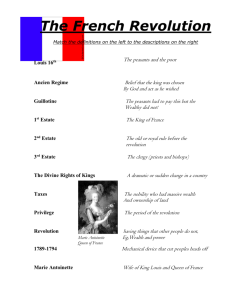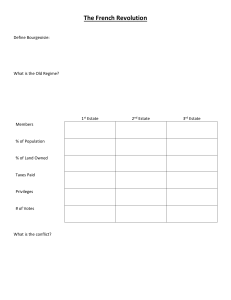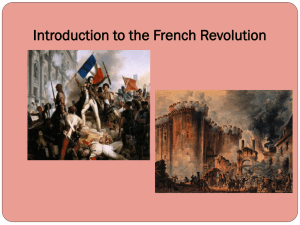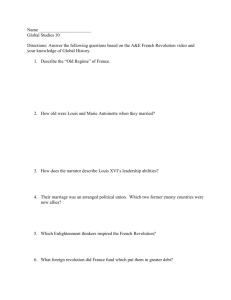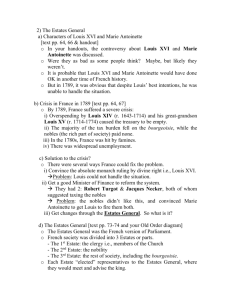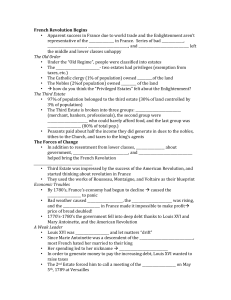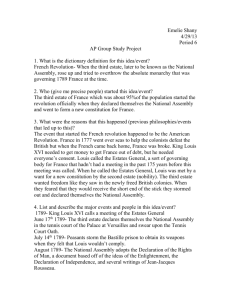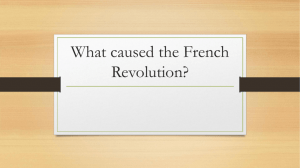French Revolution
advertisement
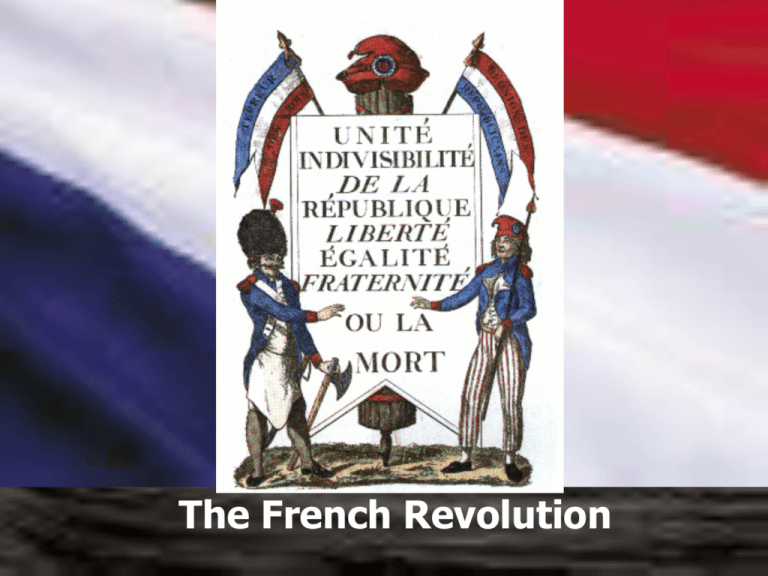
The French Revolution The Old Regime The people in French society were not treated equally. The system of feudalism in France was known as The Old Regime. Citizens were divided into three classes or estates. The Three Estates The First Estate Roman Catholic Clergy The Second Estate Nobles The Third Estate 3 types of people 1. Bourgeoisie 2. City Workers 3. Peasants Why revolt? The Enlightenment movement spread ideas everyone should be equal. The people of the 3rd estate liked that idea. The French economy was failing. Taxes were high, profits were low and food supplies were short. King Louis the XVI was weak and unconcerned about the plight of the third estate. Louis XVI attempted to tax the nobles. The nobles forced the king to call a meeting of the Estates-General an assembly of delegates from each of the three estates. Representative Government for France The meeting of the EstatesGeneral began with arguments on how to count votes. In the past one vote was cast for each estate. The third estate now wanted each delegate to have a vote. They broke with the others and voted to rename themselves The National Assembly. The members of the National Assembly claimed to represent all of the people. The king disagreed. The 3rd Estate delegates were locked out of their meeting. The Dawn of the Revolution June 20, 1789: During a meeting of the Estates General, a problem arouse about the voting procedure. Angered by the disagreement, Louis XVI locked the 3rd Estate out of the meeting during which time they reconvened in the tennis courts at Versailles. This is where they took the Tennis Court Oath-not to leave until a constitution was created. This started the beginning of the political French Revolution. Notice the fluttering curtains representing the winds of change. Between June and the beginning of August there were riots in the countryside. Peasants burned their nobles' chateaux, monasteries and buildings which housed public records. They particularly targeted documents which contained records of their feudal obligations. It was called "The Great Fear" and spread quickly throughout France. Louis XVI was worried by the action of the Third Estate and threatened to dissolve the Estates General after the tumultuous events surrounding the Tennis Court Oath. Rural and urban uprisings throughout France at this time saved the Third Estate from the King's intervention. The most famous of these uprisings is the Fall of the Bastille, which occurred on July 14, 1789. October, 1789: A crowd of Parisian women marched to Versailles to demand King Louis XVI give out free bread during a bread shortage. After camping out at Versailles overnight, the mob decided to take Louis XVI back to Paris. They insisted that the royal family return to Paris where, in fact, they would find themselves under virtual house arrest. The assembly declared that the king was suspended from office and ordered that he and his family should be imprisoned. They then called a new assembly, the Convention, to decide whether France should continue to be a monarchy. The Convention brought Louis XVI to trial on the charge of conspiring with foreign countries for the invasion of France. He was declared guilty and was sentenced to death. Louis was tried (from December 11, 1792) and convicted of high treason before the Legislative Assembly. He was sentenced to death by guillotine by 361 votes to 288, with 72 effective abstentions. Stripped of all titles and honorifics by the egalitarian, Republican government, Citizen Louis Capet was guillotined in front of a cheering crowd on January 21, 1793. Marie Antoinette was born to the great Austrian empress Maria Theresa. As a young teenager, she was obliged to wed Louis XVI of France to symbolize an alliance made between Austria and France. Ironically, in the beginning of her marriage she was much loved by the French people for her kindness to peasants and her willingness to interact with her subjects. When Louis went hunting, peasants were sometimes trampled or accidentally shot. Antoinette, who was usually following in her separate coach, would always stop to help the injured person and even take him back to the palace to be treated. "Execution of Marie Antoinette at the Place de la Révolution" Before the guillotine stands Marie Antoinette with Sanson, the same executioner who had dispatched her husband ten months before. The execution, like that of her husband, took place at the Place de la Révolution, recently renamed from Place de Louis XV (currently Place de la Concorde). Seven months after the execution of the King, shortly after the declaration of "Revolutionary Government," the Convention turned to the rest of the royal family. Fearing that Marie Antoinette and her son, the nominal King, would provide rallying points for royalists within France and abroad, a Revolutionary Tribunal indicted Marie Antoinette and her children for treason. Marie Antoinette being led to the guillotine Jack and Jill Rhyme Nursery Rhyme & History Jack and Jill story - The French (history) connection! The roots of the story, or poem, of Jack and Jill are in France. Jack and Jill referred to are said to be King Louis XVI - Jack -who was beheaded (lost his crown) followed by his Queen Marie Antoinette - Jill - (who came tumbling after). The words and lyrics to the Jack and Jill poem were made more acceptable as a story for children by providing a happy ending! The actual beheadings occurred in during the Reign of Terror in 1793. The Guillotine was a cruel form of punishment of death during the French Revolution. The Executioner cranked the blade to the top, and a mechanism released it. The blade was heavy, with its weight made the fall and the slice through the neck, severing the head from its body. About 90% of beheadings were of the third estate, about 7% from the second estate and about 3% from the first estate. Maximilien Robespierre The French lawyer and political leader, who became one of the most influential figures of the French Revolution and the principal exponent of the Reign of Terror. THE COMMITTEE OF PUBLIC SAFETY Started by Robespierre in the summer of 1793, which decided who should be considered enemies of the public. They would often try people in the morning, while having them guillotined the same afternoon. A conspiracy overthrew Robespierre. On July 27, 1794, he was barred from speaking in public and was placed Under arrest. An uprising by his supporters was stopped, and on July 28 Robespierre died on the guillotine with his other supporters. Eighty more followers of Robespierre were executed the next day.
